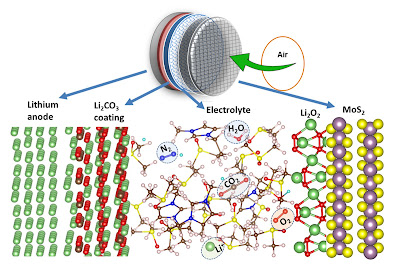 |
| "The new battery design protects the lithium metal anode with a coating of lithium carbonate. That allows lithium ions from the anode to enter the electrolyte while keeping unwanted compounds from reaching the anode. It’s easy to create this protective layer, too. The researchers just had to run a few charge-discharge cycles with a pure carbon dioxide atmosphere, and a crystal mesh of lithium carbonate accumulated." Extreme Tech |
Topics: Alternative Energy, Green Energy, Green Tech, Solar Power
The lithium-ion battery has transformed the portable electronics industry and is making inroads into energy storage on the electric grid and electrically powered transportation. Today, research laboratories around the world are seeking to develop beyond-lithium-ion batteries that are even more powerful, cheaper, safer and longer lived.
As reported in the journal Nature, a team of scientists from the University of Illinois at Chicago and the U.S. Department of Energy’s (DOE) Argonne National Laboratory has produced a new design for a beyond-lithium-ion battery cell that operates by running on air (hence, referred to as “lithium-air”) over many charge and discharge cycles. Larry Curtiss, co-principal investigator and Argonne Distinguished Fellow, observed that the team’s article was appealing to Nature because “others have tried to build lithium-air battery cells that run on air, but they failed because of little cycle life.”
“This first demonstration of a true lithium-air battery is an important step toward what we call ‘beyond-lithium-ion’ batteries.” — Amin Salehi-Khojin, assistant professor, University of Illinois at Chicago.
The problem with past technology has been that battery cells tested in the lab required a separate supply of pure oxygen (hence, referred to as lithium-oxygen batteries). As a consequence, a tank of oxygen gas would have to be part of the battery system, making it prohibitive for use in electric vehicles due to space requirements. A lithium-air battery that uses air from outside eliminates this problem.
The key features of the team’s newly developed battery cell are a new protective coating for the lithium metal anode, which prevents the anode from reacting with oxygen and hence deteriorating, and a novel electrolyte mixture that allows the cell to operate in an air atmosphere. In tests under an air environment, this cell maintained high performance during 700 cycles, far surpassing previous technology. According to Amin Salehi-Khojin, co-principal investigator and assistant professor at the University of Illinois at Chicago, “The energy storage capacity was about three times that of a lithium-ion battery, and five times should be easily possible with continued research. This first demonstration of a true lithium-air battery is an important step toward what we call beyond-lithium-ion batteries.”
Out Of thin air, Joe Harmon, Argonne National Laboratory
Comments